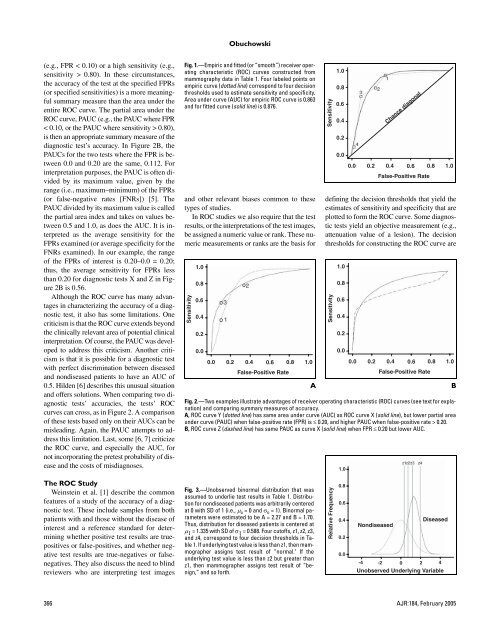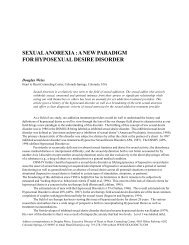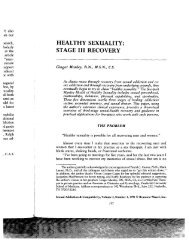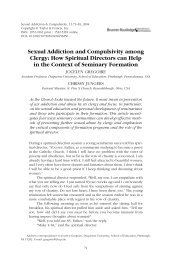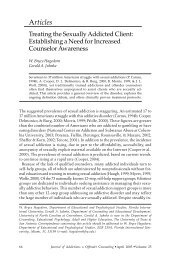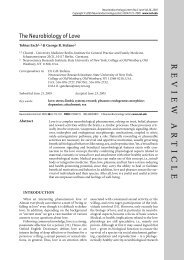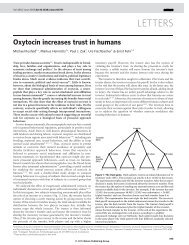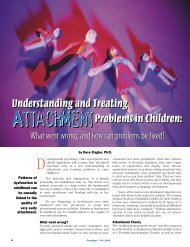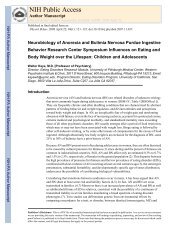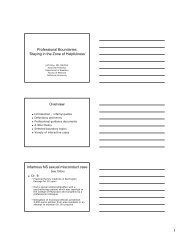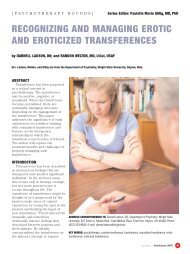<strong>ROC</strong> <strong>Analysis</strong>most lenient decision threshold whereby alltest results are positive <strong>for</strong> disease. An empiric<strong>ROC</strong> curve has h − 1 additional coordinates,where h is the number <strong>of</strong> unique testresults in the sample. In Table 1 there are 200test results, one <strong>for</strong> each <strong>of</strong> the 200 patients inthe sample, but there are only five unique results:normal, benign, probably benign, suspicious,and malignant. Thus, h = 5, and thereare four coordinates plotted in Figure 1 correspondingto the four decision thresholds describedin Table 1.The line connecting the (0, 0) and (1, 1)coordinates is called the “chance diagonal”and represents the <strong>ROC</strong> curve <strong>of</strong> a diagnostictest with no ability to distinguish patientswith versus those without disease. An <strong>ROC</strong>curve that lies above the chance diagonal,such as the <strong>ROC</strong> curve <strong>for</strong> our fictitiousmammography example, has some diagnosticability. The further away an <strong>ROC</strong> curve isfrom the chance diagonal, and there<strong>for</strong>e, thecloser to the upper left-hand corner, the betterdiscriminating power and diagnostic accuracythe test has.In characterizing the accuracy <strong>of</strong> a diagnostic(or screening) test, the <strong>ROC</strong> curve <strong>of</strong>the test provides much more in<strong>for</strong>mationabout how the test per<strong>for</strong>ms than just a singleestimate <strong>of</strong> the test’s sensitivity and specificity[1, 2]. Given a test’s <strong>ROC</strong> curve, a cliniciancan examine the trade-<strong>of</strong>fs in sensitivityversus specificity <strong>for</strong> various decision thresholds.Based on the relative costs <strong>of</strong> false-positiveand false-negative errors and the pretestprobability <strong>of</strong> disease, the clinician canchoose the optimal decision threshold <strong>for</strong>each patient. This idea is discussed in moredetail in a later section <strong>of</strong> this article. Often,TABLE 1patient management is more complex than isallowed with a decision threshold that classifiesthe test results into positive or negative.For example, in mammography suspiciousand malignant findings are usually followedup with biopsy, probably benign findings usuallyresult in a follow-up mammogram in 3–6months, and normal and benign findings areconsidered negative.When comparing two or more diagnostictests, <strong>ROC</strong> curves are <strong>of</strong>ten the only validmethod <strong>of</strong> comparison. Figure 2 illustratestwo scenarios in which an investigator,comparing two diagnostic tests, could bemisled by relying on only a single sensitivity–specificity pair. Consider Figure 2A. Supposea more expensive or risky test (represented by<strong>ROC</strong> curve Y) was reported to have thefollowing accuracy: sensitivity = 0.40,specificity = 0.90 (labeled as coordinate 1 inFig. 2A); a less expensive or less risky test(represented by <strong>ROC</strong> curve X) was reportedto have the following accuracy: sensitivity =0.80, specificity = 0.65 (labeled as coordinate2 in Fig. 2A). If the investigator is looking <strong>for</strong>the test with better specificity, then he or shemay choose the more expensive, risky test,not realizing that a simple change in thedecision threshold <strong>of</strong> the less expensive,cheaper test could provide the desiredspecificity at an even higher sensitivity(coordinate 3 in Fig. 2A).Now consider Figure 2B. The <strong>ROC</strong> curve<strong>for</strong> test Z is superior to that <strong>of</strong> test X <strong>for</strong> a narrowrange <strong>of</strong> FPRs (0.0–0.08); otherwise, diagnostictest X has superior accuracy. Acomparison <strong>of</strong> the tests’ sensitivities at lowFPRs would be misleading unless the diagnostictests are useful only at these low FPRs.Construction <strong>of</strong> Receiver Operating Characteristic Curve Based onFictitious Mammography DataMammography Results Pathology/Follow-Up Results Decision Rules 1–4(BI-RADs Score)Not Malignant Malignant FPR SensitivityNormal 65 5 (1) 35/100 95/100Benign 10 15 (2) 25/100 80/100Probably benign 15 10 (3) 10/100 70/100Suspicious 7 60 (4) 3/100 10/100Malignant 3 10Total 100 100Note.—Decision rule 1 classifies normal mammography findings as negative; all others are positive. Decision rule 2classifies normal and benign mammography findings as negative; all others are positive. Decision rule 3 classifies normal,benign, and probably benign findings as negative; all others are positive. Decision rule 4 classifies normal, benign,probably benign, and suspicious findings as negative; malignant is the only finding classified as positive. BI-RADS =Breast Imaging Reporting and Data System, FPR = false-positive rate.To compare two or more diagnostic tests, itis convenient to summarize the tests’ accuracieswith a single summary measure. Severalsuch summary measures are used in the literature.One is Youden’s index, defined as sensitivity+ specificity − 1 [2]. Note, however,that Youden’s index is affected by the choice<strong>of</strong> the decision threshold used to define sensitivityand specificity. Thus, different decisionthresholds yield different values <strong>of</strong> theYouden’s index <strong>for</strong> the same diagnostic test.Another summary measure commonlyused is the probability <strong>of</strong> a correct diagnosis,<strong>of</strong>ten referred to simply as “accuracy” in theliterature. It can be shown that the probability<strong>of</strong> a correct diagnosis is equivalent toprobability (correct diagnosis) = PREV s ×sensitivity + (1 – PREV s ) × specificity, (1)where PREV s is the prevalence <strong>of</strong> disease inthe sample. That is, this summary measure <strong>of</strong>accuracy is affected not only by the choice <strong>of</strong>the decision threshold but also by the prevalence<strong>of</strong> disease in the study sample [2]. Thus,even slight changes in the prevalence <strong>of</strong> diseasein the population <strong>of</strong> patients being testedcan lead to different values <strong>of</strong> “accuracy” <strong>for</strong>the same test.Summary measures <strong>of</strong> accuracy derivedfrom the <strong>ROC</strong> curve describe the inherent accuracy<strong>of</strong> a diagnostic test because they are notaffected by the choice <strong>of</strong> the decision thresholdand they are not affected by the prevalence <strong>of</strong>disease in the study sample. Thus, these summarymeasures are preferable to Youden’s indexand the probability <strong>of</strong> a correct diagnosis[2]. The most popular summary measure <strong>of</strong> accuracyis the area under the <strong>ROC</strong> curve, <strong>of</strong>tendenoted as “AUC” <strong>for</strong> area under curve. Itranges in value from 0.5 (chance) to 1.0 (perfectdiscrimination or accuracy). The chancediagonal in Figure 1 has an AUC <strong>of</strong> 0.5. In Figure2A the areas under both <strong>ROC</strong> curves arethe same, 0.841. There are three interpretations<strong>for</strong> the AUC: the average sensitivity over allfalse-positive rates; the average specificityover all sensitivities [3]; and the probabilitythat, when presented with a randomly chosenpatient with disease and a randomly chosen patientwithout disease, the results <strong>of</strong> the diagnostictest will rank the patient with disease ashaving higher suspicion <strong>for</strong> disease than thepatient without disease [4].The AUC is <strong>of</strong>ten too global a summarymeasure. Instead, <strong>for</strong> a particular clinical application,a decision threshold is chosen sothat the diagnostic test will have a low FPRAJR:184, February 2005 365
Obuchowski(e.g., FPR < 0.10) or a high sensitivity (e.g.,sensitivity > 0.80). In these circumstances,the accuracy <strong>of</strong> the test at the specified FPRs(or specified sensitivities) is a more meaningfulsummary measure than the area under theentire <strong>ROC</strong> curve. The partial area under the<strong>ROC</strong> curve, PAUC (e.g., the PAUC where FPR< 0.10, or the PAUC where sensitivity > 0.80),is then an appropriate summary measure <strong>of</strong> thediagnostic test’s accuracy. In Figure 2B, thePAUCs <strong>for</strong> the two tests where the FPR is between0.0 and 0.20 are the same, 0.112. Forinterpretation purposes, the PAUC is <strong>of</strong>ten dividedby its maximum value, given by therange (i.e., maximum–minimum) <strong>of</strong> the FPRs(or false-negative rates [FNRs]) [5]. ThePAUC divided by its maximum value is calledthe partial area index and takes on values between0.5 and 1.0, as does the AUC. It is interpretedas the average sensitivity <strong>for</strong> theFPRs examined (or average specificity <strong>for</strong> theFNRs examined). In our example, the range<strong>of</strong> the FPRs <strong>of</strong> interest is 0.20–0.0 = 0.20;thus, the average sensitivity <strong>for</strong> FPRs lessthan 0.20 <strong>for</strong> diagnostic tests X and Z in Figure2B is 0.56.Although the <strong>ROC</strong> curve has many advantagesin characterizing the accuracy <strong>of</strong> a diagnostictest, it also has some limitations. Onecriticism is that the <strong>ROC</strong> curve extends beyondthe clinically relevant area <strong>of</strong> potential clinicalinterpretation. Of course, the PAUC was developedto address this criticism. Another criticismis that it is possible <strong>for</strong> a diagnostic testwith perfect discrimination between diseasedand nondiseased patients to have an AUC <strong>of</strong>0.5. Hilden [6] describes this unusual situationand <strong>of</strong>fers solutions. When comparing two diagnostictests’ accuracies, the tests’ <strong>ROC</strong>curves can cross, as in Figure 2. A comparison<strong>of</strong> these tests based only on their AUCs can bemisleading. Again, the PAUC attempts to addressthis limitation. Last, some [6, 7] criticizethe <strong>ROC</strong> curve, and especially the AUC, <strong>for</strong>not incorporating the pretest probability <strong>of</strong> diseaseand the costs <strong>of</strong> misdiagnoses.Fig. 1.—Empiric and fitted (or “smooth”) receiver operatingcharacteristic (<strong>ROC</strong>) curves constructed frommammography data in Table 1. Four labeled points onempiric curve (dotted line) correspond to four decisionthresholds used to estimate sensitivity and specificity.Area under curve (AUC) <strong>for</strong> empiric <strong>ROC</strong> curve is 0.863and <strong>for</strong> fitted curve (solid line) is 0.876.and other relevant biases common to thesetypes <strong>of</strong> studies.In <strong>ROC</strong> studies we also require that the testresults, or the interpretations <strong>of</strong> the test images,be assigned a numeric value or rank. These numericmeasurements or ranks are the basis <strong>for</strong>Sensitivity1.00.80.60.40.20.00.00.20.40.6False-Positive Rate0.81.0ASensitivity1.00.80.60.40.20.00.00.2Chance diagonal0.40.6False-Positive Rate0.81.0defining the decision thresholds that yield theestimates <strong>of</strong> sensitivity and specificity that areplotted to <strong>for</strong>m the <strong>ROC</strong> curve. Some diagnostictests yield an objective measurement (e.g.,attenuation value <strong>of</strong> a lesion). The decisionthresholds <strong>for</strong> constructing the <strong>ROC</strong> curve areSensitivity1.00.80.60.40.20.00.00.20.40.6False-Positive RateFig. 2.—Two examples illustrate advantages <strong>of</strong> receiver operating characteristic (<strong>ROC</strong>) curves (see text <strong>for</strong> explanation)and comparing summary measures <strong>of</strong> accuracy.A, <strong>ROC</strong> curve Y (dotted line) has same area under curve (AUC) as <strong>ROC</strong> curve X (solid line), but lower partial areaunder curve (PAUC) when false-positive rate (FPR) is ≤ 0.20, and higher PAUC when false-positive rate > 0.20.B, <strong>ROC</strong> curve Z (dashed line) has same PAUC as curve X (solid line) when FPR ≤ 0.20 but lower AUC.1.00.81.0BThe <strong>ROC</strong> StudyWeinstein et al. [1] describe the commonfeatures <strong>of</strong> a study <strong>of</strong> the accuracy <strong>of</strong> a diagnostictest. These include samples from bothpatients with and those without the disease <strong>of</strong>interest and a reference standard <strong>for</strong> determiningwhether positive test results are truepositivesor false-positives, and whether negativetest results are true-negatives or falsenegatives.They also discuss the need to blindreviewers who are interpreting test imagesFig. 3.—Unobserved binormal distribution that wasassumed to underlie test results in Table 1. Distribution<strong>for</strong> nondiseased patients was arbitrarily centeredat 0 with SD <strong>of</strong> 1 (i.e., µ o = 0 and σ o = 1). Binormal parameterswere estimated to be A = 2.27 and B = 1.70.Thus, distribution <strong>for</strong> diseased patients is centered atµ 1 = 1.335 with SD <strong>of</strong> σ 1 = 0.588. Four cut<strong>of</strong>fs, z1, z2, z3,and z4, correspond to four decision thresholds in Table1. If underlying test value is less than z1, then mammographerassigns test result <strong>of</strong> “normal." If theunderlying test value is less than z2 but greater thanz1, then mammographer assigns test result <strong>of</strong> “benign,”and so <strong>for</strong>th.Relative Frequency0.80.60.40.20.0DiseasedNondiseased-4 -2 0 2 4Unobserved Underlying Variable366 AJR:184, February 2005


